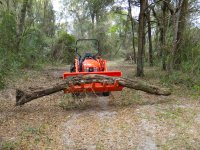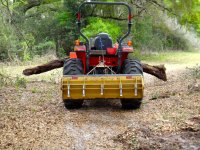I'll throw my two-cents in as I'm a new owner of a Kubota
BX25D. It comes with the Front End Loader (FEL), Mid-Mount Mower (MMM), and Backhoe (BH). As I will be mowing 90% of the time I use the tractor, I opted for the MMM. Course, as soon as I got the tractor, I immediately started finding all kinds of uses for the FEL and forks. To that, I suggest a 'quick attach' to swap between these. You can also get a 'quick hitch' for the 3point end, but if you do, make sure all your implements are sized for it (the width of the connecting points is fixed on the quick hitch) - very important. As for the lifting capacity, with the forks on it, I can lift around 400lbs - which was a bit of a disappointment to me. So, lesson one for me is to pay attention to the lifting capacity of both ends. If you can afford it, get a size bigger than you anticipate using.
Lesson two is that you will spend money after purchase on supplies, add-ons, etc. soon after you buy your tractor. Figure at least a $1000 but more like $2000.
Lesson three is that if you have the cash, have a shopping list of implements, but no urgency on buying them, consider craigslist to find them used and save a lot. I financed many of my implements with my initial purchase at full retail and then realized this fact afterwards. Granted, some implements are specific to your model, e.g. MMM, FEL, BH, but the 3point implements are often commonly found on craigslist. That, or 3rd party companies like Everything Attachments, Tractor Supply, etc.
Lesson four is weight. The entry level Sub Compact Utility Tractors (SCUTs) typically weight less than 2000lbs. That's great if you're working in your yard on a regular basis due to tearing up the grass with the tires and driving over septic tanks. The light weight will work against you if you're planning on dragging heavy stuff like full length trees, plowing a garden, etc.
Lesson five is as several have mentioned - a dealer with whom you feel comfortable. I knew in advance that I knew little about modern day tractors as I grew up on a FarmAll tractor which is very different in many ways. So, having a dealer who would take the time to explain things to me was important. Check their BBB credit rating. For some dealers, $20,000 to $30,000 is chump-change (hardly worth their time) - you'd be surprised. Further, some dealers do not stock tractors or parts and have to order everything. Ask their mechanics a few questions to get a feel for their competence. When I was shopping, the dealer I liked initially had no inventory, said it would take at least three weeks to get my tractor to his lot, and his mechanic couldn't answer questions about whether or not I could use the MMM if the BH was attached at the same time due to the BH sub-frame getting in the way. I walked away from him.
Lesson six is also as several have mentioned - how you feel sitting on the seat of the tractor and operating it. You're the one spending your time in the seat, getting on and off it, changing the implements, etc. There are different pedal designs and sizes. Some models got knobs and levers sticking out all over the place and while easier to use when in the seat, makes it harder to get on and off the tractor. If you're hefty sized, this can be an issue as you'll bang into levers trying to get in and out of the seat. Since I have the MMM, it has the grass deflector that sticks out. And since it is in the way of getting on and off the tractor, I specifically get on and off the tractor from the left side.
Lesson seven - sorting wheat from chaff in the sales pitch. Youtube is full of great videos and I encourage you to research some models there. But what you'll also see are videos where dealers and manufacturers compare their models versus a competitors. Pay attention to what is really important. Is that 'drive over deck' for the MMM really that big of a deal? Maybe - depends on you. Does it really matter if you can pick up the front end of you tractor with the loader at low RPMs? Is a 12volt car power supply really a selling point? Stamped versus fabricated decks? Blah, blah, blah? Some of these things may matter to you but many will not. It all depends on how long you'll be in the seat on any given day. A guy who puts in 10 hours a week on his tractor may want the fancy suspension seat. If you're using it two hours a week, spend the money on something else. What's first and foremost important is the WORK part of the tractor. Then consider luxuries and upgrades. So, beware of the dog and pony show stuff.
Lesson eight - spreadsheets or comparison lists. If you want to build a comparison list of all the units you're considering, that's great. There are several Excel spreadsheets on this website already. This is INITIAL research. List all the models mentioned to you, look at their stats (manufacturer websites don't always use the same ratings, e.g. lift capacity of the 3point or FEL at different distances from the tractor or ground), and get it down to 3 to 5 models - all of which meet your technical needs. Then throw the list away and go look at those specific models. Resist the temptation to buy one model over another over 100lbs of lifting ability. 500lbs, sure. But not 100lbs.
And finally, lesson nine - keep researching and learning before you buy. The TractorByNet (TBN) forums are loaded with info. Youtube has tons of videos.
Well, that was more than two-cents and it may be a lot to consider, but these are the lessons I learned. Some I knew before I bought. Others, I wish I'd known before I bought. Hope it helps.

